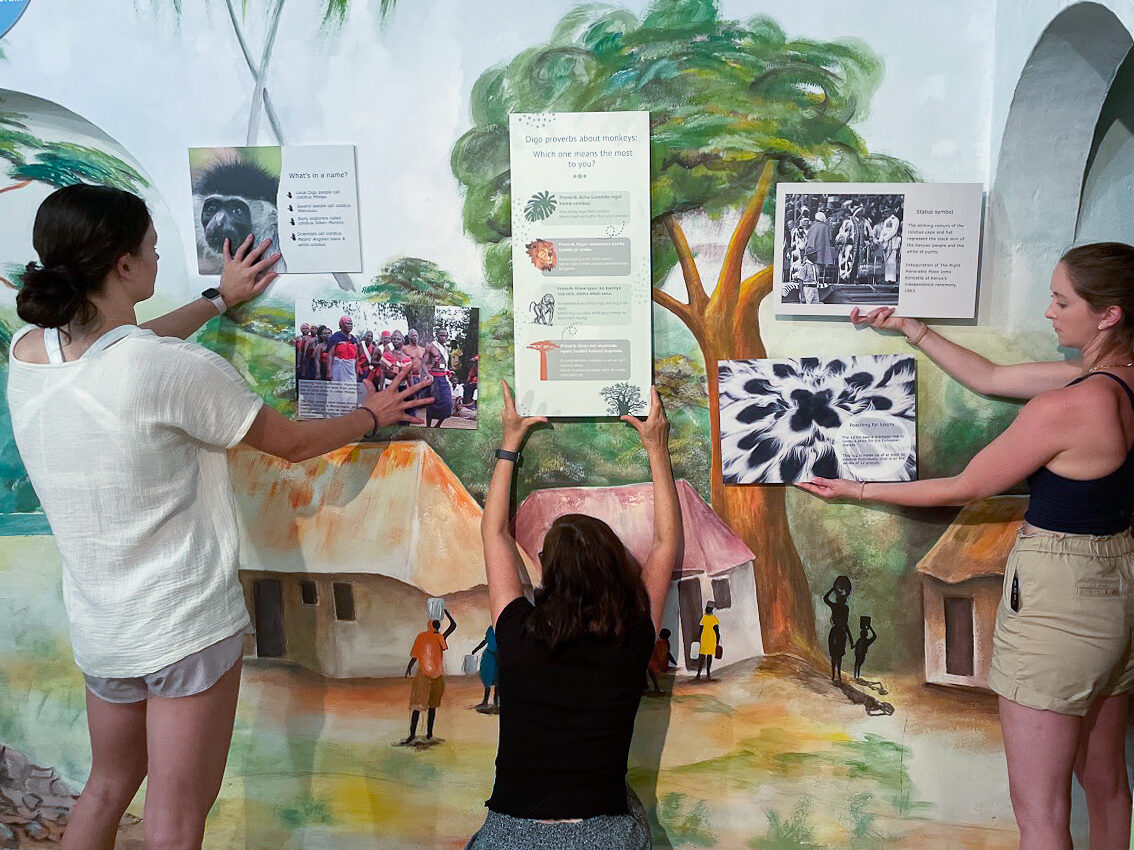Summer Stories: Georgetown Team Shores Up Conservation Center in Coastal Kenya
This summer, a group of Georgetown undergraduates and professors traveled to the Diani Beach region of Kenya to bring their coursework to life by building out educational assets at the Colobus Conservation Center.
Founded in 1997 to protect its namesake monkey, Colobus Conservation is a nonprofit dedicated to the coastal forest habitat of eastern Kenya. Today, the organization’s mission spans far beyond the Colobus monkey and encompasses a slew of programs organized around animal welfare, ecology, conservation and eco-tourism.
From the Classroom to the Coastline

During the spring semester, students designed an educational visitors center for the conservation center with two audiences in mind: both local schoolchildren and tourists drawn to the coast. The materials they designed were created to both augment local educational efforts and to inform visitors about the ecology of their vacation destination.
“As a biological physics major and environmental activist at Georgetown, my academic trajectory met a crossroads through this program,” reflects Victoria Boatwright (C’22). “I was able to see how scientific fieldwork and environmental knowledge connected to local conservation efforts and mitigation of human impacts.”
Before journeying across the Atlantic, the team outlined their goals for the content of the space. They wanted the information contained in the educational wing to consider the biodiversity of the local ecosystem, the challenges facing that biodiversity, what the conservation center has already done to combat those challenges and what visitors can do to help going forward.
“We really emphasized the final section to incite grassroots conservation that spreads through the community based on the message they take away from the exhibit,” explains John Katial (C’25). “We used the Georgetown Maker Hub to make primate cutouts and QR codes, brainstormed graphics and wall displays that would help us convey ideas in a meaningful and informative manner, decided on murals for the four walls and planned out the logistics of the space.”
During their three weeks in Kenya, the team took up the physical labor of realizing the space, including painting walls, drilling, sanding, hanging informational panels and general construction work, alongside the executive work of ensuring that the center’s managers and stakeholders are well-equipped to incorporate the educational wing into their regular programming.
Studying Primate-Human Interactions

The team also collected data for a study of primate-human interactions at coastal hotels in the Diana Beach area.
“Ongoing primate interactions not only pose health risks to humans, but often lead hotel managers to take aggressive actions against animals whose habitats have been overtaken by tourist developments,” explains Katial. “To better understand these interactions, we spent many afternoons and mornings collecting data on the frequency and nature of these interactions as well as the general primate behavior on hotel premises.”
One of the conservation center’s fledgling missions was to tackle the issue of the deaths of Colobus monkeys along a heavily-trafficked thoroughfare through the community. These primate-human interactions pose risks to both humans and monkeys.
“It was eye-opening to interact so closely with the monkeys of Diani,” says Boatwright. “We saw firsthand how much humans have encroached into their habitat, and what we can do to mitigate our negative impacts on wildlife.”
Alongside the data collection, the team assisted conservation center staff with general day-to-day activities – food collection for animals in the reintroduction program, upkeep of facilities and assisting veterinary teams with monkey rescues.
The group included Annie Maines (C’22), Alexa MacKinnon (C’22), Greg Latronica (C’24), Jane Doherty (C’23), Shelby Benz (SFS’23) and Kathryn Fouss (MSB’23). The trip was led by Angela van Doorn, Shauna Bennett and Dail Chapman. Three students — Boatwright, Katial and Doherty — were members of the 2022 Class of Royden B. Davis Fellows . Each year, as part of its expansion of support for high impact learning opportunities, Georgetown’s College of Arts & Sciences awards summer research and experiential learning fellowships in honor Fr. Davis, who served as Dean from 1966 to 1989.
Funding and institutional support for the project came from the Department of Biology, The Earth Commons—Georgetown’s Institute for Environment & Sustainability, and the Center for New Designs in Learning & Scholarship.
-by Hayden Frye (C’17)
